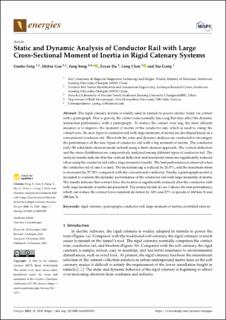| dc.contributor.author | Feng, Xiaohe | |
| dc.contributor.author | Gao, Shibin | |
| dc.contributor.author | Song, Yang | |
| dc.contributor.author | Hu, Zeyao | |
| dc.contributor.author | Chen, Long | |
| dc.contributor.author | Liang, Tao | |
| dc.date.accessioned | 2023-11-08T06:52:47Z | |
| dc.date.available | 2023-11-08T06:52:47Z | |
| dc.date.created | 2023-06-16T09:54:47Z | |
| dc.date.issued | 2023 | |
| dc.identifier.citation | Energies. 2023, 16 (4), . | en_US |
| dc.identifier.issn | 1996-1073 | |
| dc.identifier.uri | https://hdl.handle.net/11250/3101238 | |
| dc.description.abstract | The rigid catenary system is widely used in tunnels to power electric trains via contact with a pantograph. Due to gravity, the contact wire normally has a sag that may affect the dynamic interaction performance with a pantograph. To reduce the contact wire sag, the most efficient measure is to improve the moment of inertia of the conductor rail, which is used to clamp the contact wire. Six new types of conductor rail with large moments of inertia are developed based on a conventional conductor rail. Then both the static and dynamic analyses are conducted to investigate the performance of the new types of conductor rail with a big moment of inertia. The conductor rail’s 3D solid finite element model is built using a finite element approach. The vertical deflection and the stress distribution are comparatively analyzed among different types of conductor rail. The analysis results indicate that the vertical deflection and maximum stress are significantly reduced when using the conductor rail with a large moment of inertia. The best performance is observed when the conductor rail of case 1 is used. The maximum sag is reduced by 28.37%, and the maximum stress is decreased by 27.76% compared with the conventional conductor. Finally, a pantograph model is included to evaluate the dynamic performance of the conductor rail with large moments of inertia. The results indicate that contact force fluctuation is significantly reduced after the conductor rails with large moments of inertia are presented. The conductor rail of case 1 shows the best performance, which can reduce the contact force standard deviation by 32% and 27% at speeds of 160 km/h and 200 km/h. | en_US |
| dc.language.iso | eng | en_US |
| dc.publisher | MDPI | en_US |
| dc.rights | Navngivelse 4.0 Internasjonal | * |
| dc.rights.uri | http://creativecommons.org/licenses/by/4.0/deed.no | * |
| dc.title | Static and Dynamic Analysis of Conductor Rail with Large Cross-Sectional Moment of Inertia in Rigid Catenary Systems | en_US |
| dc.title.alternative | Static and Dynamic Analysis of Conductor Rail with Large Cross-Sectional Moment of Inertia in Rigid Catenary Systems | en_US |
| dc.type | Peer reviewed | en_US |
| dc.type | Journal article | en_US |
| dc.description.version | publishedVersion | en_US |
| dc.source.volume | 16 | en_US |
| dc.source.journal | Energies | en_US |
| dc.source.issue | 4 | en_US |
| dc.identifier.doi | 10.3390/en16041810 | |
| dc.identifier.cristin | 2155167 | |
| cristin.ispublished | true | |
| cristin.fulltext | original | |
| cristin.qualitycode | 1 | |

